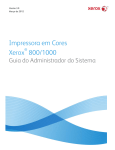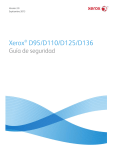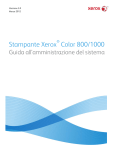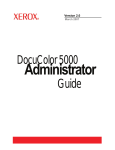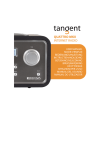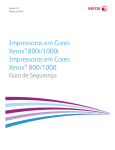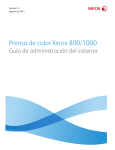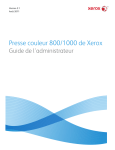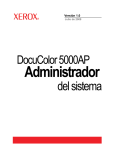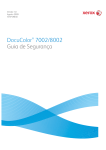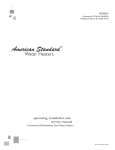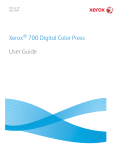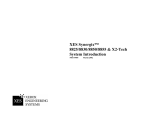Download Xerox Color 800/1000 Press Deb VanLoan, Erik Nielsen, Cindy Wells
Transcript
Version 3.0 March 2012 ® Xerox Color 800/1000 Press System Administration Guide Deb VanLoan, Erik Nielsen, Cindy Wells ® ® © 2012 Xerox Corporation. All rights reserved. Xerox , and Xerox and Design are trademarks of Xerox Corporation in the United States and/or other countries. ® ® ™ ™ ™ FreeFlow , SquareFold , Xerox prInteract , MeterAssistant , SuppliesAssistant , and ™ RemoteAssistant are trademarks of Xerox Corporation in the United States and/or other countries. Product status, build status, and/or specifications are subject to change without notice. Microsoft, Windows, Windows 2000, Windows XP, Windows Vista, and Windows 7 are registered trademarks of Microsoft Corporation. ® PANTONE is a registered trademark of Pantone, Inc. Macintosh is a registered trademark of Apple Computer, Inc., registered in the US and other countries. Elements of Apple's Technical User Documentation used by permission from Apple Computer, Inc. Adobe, the Adobe logo, Acrobat, the Acrobat logo, Acrobat Reader, Distiller, Adobe PDF logo, Adobe PDF JobReady, Illustrator, InDesign, and Photoshop are registered trademarks of Adobe Systems, Inc. PostScript is an Adobe registered trademark used with the Adobe PostScript Interpreter, the Adobe page description language, and other Adobe products. This product is not endorsed or sponsored by Adobe Systems, publisher of Adobe Photoshop. ® ® Fiery , is a registered trademark of Electronics For Imaging, Inc. Creo is a registered ™ ® trademark of Creo, Inc. Plockmatic is a trademark of CFS Products Inc. GBC and ™ AdvancedPunch are trademarks or registered trademarks of General Binding Corporation. ® ™ GBC , and e/Binder 200 are trademarks or registered trademarks of General Binding Corporation. HP, HPGL, HPGL/2, and HP-UX are registered trademarks of Hewlett-Packard ® Corporation. Netscape is registered trademark of Netscape Communications. UNIX® ™ is a registered trademark of the Open Group. Mozilla FireFox is a trademark of Mozilla Foundation. Table of Contents 1 Administrator overview...........................................................................1-1 Logging on as Administrator...........................................................................................1-1 Remote services....................................................................................................................1-1 Automatic Meter Reading (AMR)/Automatic Supplies Replenishment (ASR)......................................................................................1-2 Technical Key Operator (TKO).........................................................................................1-3 Backing up/transferring the stock library...................................................................1-3 2 Maintenance on UI..................................................................................2-1 Maintenance tab..................................................................................................................2-2 Dry ink/toner cleaning..........................................................................................2-2 Charge corotron cleaning....................................................................................2-3 3 Test Print option........................................................................................3-1 Using the Test Print option...............................................................................................3-2 Test Print option for 2nd Bias Transfer Roll................................................................3-4 Running the first set of test prints...................................................................3-4 Evaluating the first set of test prints..............................................................3-5 Adjusting the test prints......................................................................................3-5 Selecting the 2nd Bias Transfer Roll settings...............................................3-6 4 Paper curl correction................................................................................4-1 Paper curl overview..............................................................................................................4-1 Paper Curl Correction options.........................................................................................4-2 1 Sided-Face Up option........................................................................................4-3 1 Sided-Face Down option..................................................................................4-4 2 Sided option..........................................................................................................4-4 Correcting the paper curl.....................................................................................4-5 5 System Settings..........................................................................................5-1 User Interface........................................................................................................................5-1 Fault Details window.............................................................................................5-2 Setting the default value for Fault Details Window....................5-3 Default Language...................................................................................................5-4 Change administrator password......................................................................5-5 Resetting the Technical Key Operator password........................................5-5 Manage Stock Library Window.........................................................................5-6 Setting the date and time................................................................................................5-8 System......................................................................................................................................5-9 ® Xerox Color 800/1000 Press System Administration Guide i Table of Contents Productivity Mode................................................................................................5-10 Single Paper Weight chart...................................................................5-11 Mixed Paper Weight chart..................................................................5-12 Selecting the productivity mode options......................................5-12 NVM Read/Write..................................................................................................5-13 Using the NVM Read/Write feature................................................5-13 Auto Resume After Fault Clearance..............................................................5-14 Power Saver............................................................................................................5-15 System PC & Print Engine....................................................................5-16 Print Engine Only....................................................................................5-16 Print Engine Only If No PC Communication For.........................5-16 Exit Power Saver......................................................................................5-16 Setting the power saver options.......................................................5-16 Auto resume after pause..................................................................................5-17 Auto logoff.............................................................................................................5-18 Attention Sounds.................................................................................................5-18 Tray Options........................................................................................................................5-19 Selecting the Tray Options settings..............................................................5-20 Output Devices...................................................................................................................5-21 High Capacity Stacker Settings......................................................................5-22 Perfect Binder Settings.......................................................................................5-22 Selecting the Output Device options...........................................................5-22 Image Quality tab.............................................................................................................5-24 Fuser Refresh Mode.............................................................................................5-25 Full Width Array Overview..............................................................................................5-26 Adjusting Automatic Tone Reproduction Curve......................................5-27 Adjusting Automatic Density Uniformity...................................................5-27 6 Profiles...........................................................................................................6-1 Enter/exit the Profiles.........................................................................................................6-2 Alignment................................................................................................................................6-3 Alignment information.........................................................................................6-4 Automatic alignment information.....................................................6-4 Things to consider when creating/using an alignment profile.......................................................................................................6-4 Adjustments to the position of the output image.......................6-5 Automatic Alignment (Full Width Array)......................................................6-6 Alignment options..................................................................................................6-9 Before creating/using an alignment profile.................................................6-9 Create/edit an Alignment profile..................................................................6-10 Fold Adjustment.................................................................................................................6-12 ii ® Xerox Color 800/1000 Press System Administration Guide Table of Contents Fold Adjustment information..........................................................................6-13 New/edit bi-fold single/multiple sheets adjustment procedure..........................................................................................................6-14 New/edit bi-fold multiple sheets stapled adjustment procedure..........................................................................................................6-16 New/edit c-fold adjustment procedure.......................................................6-18 New/edit z-fold adjustment procedure.......................................................6-21 New/edit z-fold half-sheet adjustment procedure.................................6-23 Finishing Devices...............................................................................................................6-25 ® Xerox Color 800/1000 Press System Administration Guide iii Table of Contents iv ® Xerox Color 800/1000 Press System Administration Guide Administrator overview 1 The Administrator mode allows you to set the default settings for your machine in order to fit your individual requirements. You can change the settings for a variety of features, such as the language to display on the UI, timers, changing the Administrator password, creating custom paper and alignment profiles, and more. Logging on as Administrator Use the following procedure to enter and exit the Administrator mode: 1. Select the Logon button from the main UI window. The Logon screen appears. 2. From the Logon screen select Administrator. 3. Use the keyboard to enter the Administrator password. The default password is five ones (11111). Note For security reasons, only asterisks are displayed on the screen. 4. Select the OK button. Note It is recommended that you change the Administrator password as soon as possible after installing the machine in order to prevent unauthorized access to the Administrator mode. 5. To exit the Administrator mode, select the Logoff button. Remote services The remote services program is offered for your machine. Remote services provides Xerox with up-to-the-minute information about your machine’s current state, including: • A secure internet connection between the machine and Xerox using Secure Socket Layer (SSL) protocols and 128-bit encryption; only machine performance information is sent to Xerox through this connection ® Xerox Color 800/1000 Press System Administration Guide 1-1 Administrator overview • Quick identification of potential problems • Quick and accurate diagnoses of problems • Faster resolution of issues, often occurring in less time than sending a service person • Automatically generating and sending current meter reads directly to Xerox • Scheduling maintenance calls that are convenient to your schedule and allow you to maximize your production time Note Remote services may not be available in your area or some customers may wish to decline program. For more information on this program, contact the Xerox Customer Support Center or go to www.xerox.com. Remote services includes Automatic Meter Reading (AMR) and Automatic Supplies Replenishment (ASR). Automatic Meter Reading (AMR)/Automatic Supplies Replenishment (ASR) Automatic Meter Reading (AMR) and Automatic Supplies Replenishment (ASR) are available with your machine through the following: ™ • RemoteAssistant is a feature within certain Xerox engines that allows customers to authorize a Xerox specialist to remotely access the User Interface (UI) on the print server in order to help guide the customer through corrective actions. For more information, go to www.xerox.com/printeract. 1-2 ® Xerox Color 800/1000 Press System Administration Guide Administrator overview Technical Key Operator (TKO) The Technical Key Operator (TKO) is a person who is certified by Xerox to carry out and perform certain maintenance activities that are normally performed by a customer service engineer (CSE). In order to become a TKO for your machine, you must complete the mandatory Xerox Productivity Plus (XPP) program. As stated previously, Xerox Productivity Plus (XPP) is a mandatory, customer self-maintenance program that is available with your machine. Through the XPP program, Xerox provides qualified customers with the supplies, documentation, support, and the Technical Key Operator (TKO) training required to perform simple diagnostics, routine maintenance tasks, and some repairs which formerly were completed by a Xerox customer service person. Upon successful completion of the XPP training, your trained person (TKO), receives a mini-service manual and tool kit and is certified by a Xerox Service Trainer that he or she can complete the specific program/machine tasks. Using XPP, you can maintain better control of resources and job scheduling by planning and scheduling basic maintenance at convenient times, rather than waiting for a Xerox customer service person. XPP is a productivity initiative for which the training can be at your location or an agreed upon Xerox location. Xerox Productivity Plus enhances your Xerox full-service maintenance agreement by providing better information to your Xerox Service Representative before making a service call. Xerox continues to monitor the progress of the TKO to ensure that the machine is performing at optimum levels. Note For more information on this program and/or for training information, contact the Xerox Customer Support Center or go to www.xerox.com. Backing up/transferring the stock library Any stock that you have created/copied and stored in the Stock Library can be backed up and/or transferred to another machine’s PC User Interface (UI) by using an external USB flash drive. Note A USB flash drive is required to copy (backup) and/or transfer files from one machine’s PC UI to another machine’s PC UI. 1. Insert the USB flash drive into a USB port on the machine’s PC. 2. On the machine’s PC UI, open My Computer. 3. Browse to the directory C:\users\XRX\Xerox\ColorPress\UI\public\stock directory. ® Xerox Color 800/1000 Press System Administration Guide 1-3 Administrator overview Stocks that were created/copied and stored in the library are distinguished by the .stock extension. 4. Select all the files in the stock directory with the .stock extension. 5. Select Edit > Copy (or Ctrl > C). 6. Open the directory of the USB flash drive. 7. Select Edit > Paste (or Ctrl > V). The files are copied onto the USB flash drive. 8. Close both directories. 9. Remove the USB flash drive from the machine’s PC. The .stock files can remain on the USB flash drive as a backup copy. Store the USB flash drive in a safe, secure location. 10. If desired, copy the files onto a different machine’s PC by completing all the previous steps in this procedure. 1-4 ® Xerox Color 800/1000 Press System Administration Guide Maintenance on UI 2 Selecting Maintenance on the UI opens a window which displays a status of each consumable. Note When a Customer Replaceable Unit (CRU) consumable item is depleted, the machine automatically interrupts the current job and does not restart until the consumable is replaced. Note The machine does not interrupt a job or stop running if a Technical Key Operator Replaceable Unit (TKORU) status indicates a low or depleted level. Your TKORU may continue to perform as expected far beyond the average life indicator. The Technical Key Operator (TKO) uses this status indicator information each time service is performed on your machine. Important The charge corotrons and drum cartridges can be replaced ONLY by a trained, qualified Technical Key Operator (TKO) ® Xerox Color 800/1000 Press System Administration Guide 2-1 Maintenance on UI Maintenance tab Selecting the Maintenance tab opens a window which displays options for cleaning particular components inside your machine. The Maintenance screen is divided into two sections; Charge Corotron Cleaning, and Toner Cleaning. The Maintenance cleaning options are listed below: • Charge Corotron Cleaning: Allows you to clean one or all of the charge corotrons. You may want to run this cleaning procedure if you are having certain image quality issues, such as banding or mottling. Refer to the User Guide, the Problem solving/Image quality section for more information. • Toner Cleaning: Allows you to clean one or all of the dry ink/toner cartridge systems. You may want to run this cleaning procedure if you are having certain image quality issues, such as white or dark spots or blotches on the prints. These spots or blotches are caused by dry ink/toner adhering to the drum. Refer to the User Guide, the Problem solving/Image quality section for more information. Related Topics: Dry ink/toner cleaning Charge corotron cleaning Dry ink/toner cleaning The following cleaning procedure purges the system of any residual dry ink/toner clumps that possibly collected in the devleoper module. 2-2 ® Xerox Color 800/1000 Press System Administration Guide Maintenance on UI Perform the following steps to clean one or all of the dry ink/toner cartridge dispensers. Note It is recommended that you run a few test prints before performing the cleaning procedure. After the Start Cleaning button is selected, the system automatically generates a test print. This allows you to compare the before and after prints for image quality. 1. Logon as Administrator. 2. Select Maintenance from the main UI. The Maintenance window opens. 3. Select the Maintenance tab. 4. Select the desire dry ink/toner(s) to be cleaned. 5. Select the Start Cleaning button to begin the cleaning process. 6. Select the desired paper tray and feed orientation (Long Edge Feed, or Short Edge Feed). 7. Select the Start button to begin. When the process is complete, a “Cleaning is complete” message will appear on the screen. 8. Select the Close button to exit and return to the main UI. Related Topics: Logging on as Administrator Charge corotron cleaning Perform the following steps to clean one or all of the charge corotrons. 1. Logon as Administrator. 2. Select Maintenance from the main UI. The Maintenance window opens. 3. Select the Maintenance tab. 4. Select the desire corotron(s) to clean. 5. Select the Start Cleaning button to begin the cleaning process. When the process is complete, a “Cleaning is complete” message will appear on the screen. 6. Select the Close button to exit and return to the main UI. Related Topics: Logging on as Administrator ® Xerox Color 800/1000 Press System Administration Guide 2-3 Maintenance on UI 2-4 ® Xerox Color 800/1000 Press System Administration Guide Test Print option 3 The Test Print option is available only when you are logged on as Administrator. The Test Print option is available with all Advanced Stock Setup options. Please read the following information before using the Test Print option. • It is recommended that you choose only one option at a time, and then run a set of test prints to evaluate the output. This helps you determine whether or not that option is providing the desired printed output. • If you determine that the output is unacceptable after running test prints, either further adjust the value for a particular option (if applicable) and run more test prints or return the option to its default value and continue to the next option. • If you want multiple Advanced Stock Setup options selected, individually select each option, run Test Prints, and evaluate the output. After you determine that the output for the selected option is acceptable, then you can select another option to adjust. • It is important to remember that any settings for a particular option that is used today for a specific print job may not achieve the same desired outcome/output when used on different day for that same print job. This is especially relevant if the room in which the machine is located experiences changes in temperature and humidity. • You may need to continually repeat procedures and test prints for any Advanced Stock Setup option until you achieve acceptable output prints. • If you determine that your output still is unacceptable after repeating procedures and test prints multiple times, call your Customer Support Center for help/assistance. Related Topics: Test Print option for 2nd Bias Transfer Roll Using the Test Print option ® Xerox Color 800/1000 Press System Administration Guide 3-1 Test Print option Using the Test Print option Use the following procedure to select the various Advanced Stock Setup options for a new stock entry from the Manage Stock Library window. 1. Logon as Administrator. 2. Perform one of the following: a) Create a new stock entry (either from the Manage Stock Library window or from the Tray Properties window), or b) Copy an existing stock entry (either from the Manage Stock Library window or from the Tray Properties window), or c) Modify an existing stock entry (from the Manage Stock Library window) by selecting the Properties button. 3. From either the New Stock Setup or Stock Properties window, select/modify the attributes as required, including entering a new stock name. 4. Select the Advanced Setup button. The Advanced Stock Setup window opens. 5. Select the Test Print button. The test print window for that specific stock opens. 3-2 ® Xerox Color 800/1000 Press System Administration Guide Test Print option 6. Select the desired test print settings, including output quantity, and select Start. Obtain your printed output from the output area of the machine. 7. Evaluate the printed output. It may take multiple adjustments to the Advanced Stock Setup options and running test prints before the printed output meets customer satisfaction. 8. Select OK to close the Advanced Stock Setup window. 9. Select OK to save and close either the New Stock Setup window or the Stock Properties window. 10. Select Close to exit Manage Stock Library. 11. Select Logoff to exit the Administrator mode. Related Topics: Logging on as Administrator ® Xerox Color 800/1000 Press System Administration Guide 3-3 Test Print option Test Print option for 2nd Bias Transfer Roll When using the 2nd Bias Transfer Roll option, always run test prints and evaluate the output before continuing. When the Test Print button is selected, the Test Print Setup: 2nd Bias Transfer Roll window is displayed: When the Start button is selected, there are always eleven (11) test prints generated: • 5 test prints will have more bias applied to them (more transfer voltage) • 5 test prints will have less bias applied to them (less transfer voltage) • 1 test print will be the median range (this is test print number 6) The 11 test prints are sent to the output area in the N-1 order (with test print 11 being the last one printed and the top one on the stack of prints). Related Topics: Running the first set of test prints Evaluating the first set of test prints Adjusting the test prints Selecting the 2nd Bias Transfer Roll settings Running the first set of test prints When running test prints for the first time, simply select the desired tray, sides images (Side 1 or Sides 1 and 2), and the Color Mode, and then select Start. 3-4 ® Xerox Color 800/1000 Press System Administration Guide Test Print option Note You do not need to select any other items, such as Change Percentage, for this first set of test prints. The 11 test prints are generated and sent to the output area of the machine. Evaluating the first set of test prints After the 11 test prints are generated, retrieve and review the test prints to find the one with the best image quality. For example, if the best image quality is on test print 5, this is the number you enter for the Best Test Print value on Test Print Selection: 2nd Bias Transfer Roll window: Note The default value is 6. Adjusting the test prints Selecting the Adjust Test Prints button returns you to the Test Print Setup: 2nd Bias Transfer Roll window. Notice that the number 5 is already entered as the Change Percentage value. (You entered this number for the Best Test Print value on Test Print Selection: 2nd Bias Transfer Roll window.) Simply select Start again to generate another 11 test prints. Retrieve and evaluate the next set of test prints for best image quality. Select the desired button depending on whether or not the image quality is acceptable. ® Xerox Color 800/1000 Press System Administration Guide 3-5 Test Print option Selecting the 2nd Bias Transfer Roll settings Use the following procedure to select the settings for the 2nd Bias Transfer Roll (on the Advanced Stock Setup window). 1. Logon as Administrator. 2. Select Stock Library. The Manage Stock Library window opens. 3. Perform one of the following: a) Select the Create New button or b) Select the desired stock from either the RML or the Stock Library list, and then select the Copy button or c) Select the desired stock from either the RML or the Stock Library list, and then select the Properties button. Either the New Stock Setup window or the Stock Properties window opens. 4. Modify the attributes as required. 5. Select the Advanced Setup button. The Advanced Stock Setup window opens. 6. Select the desired 2nd Bias Transfer Roll settings for Side 1 and/or Side 2 as required by using the up/down arrow buttons. 3-6 ® Xerox Color 800/1000 Press System Administration Guide Test Print option 7. Select the 2nd Bias Transfer Roll Test Print button. The Test Print Setup - 2nd Bias Transfer Roll window opens. 8. Select the desired test print settings, including output quantity, and select Start. Once the test prints are completed, the machine displays the following message: 9. Select either: a) Bias Acceptable: Select this if the output meets customer satisfaction. This closes the current window and returns you to the Advanced Stock Setup window. b) Adjust Test Prints: Select this if the output does not meet customer satisfaction and requires further adjusting. ® Xerox Color 800/1000 Press System Administration Guide 3-7 Test Print option This returns you to the The Test Print Setup - 2nd Bias Transfer Roll window where you can make further adjustments and run additional test prints. Repeat this step as required until the desired output is achieved. 10. Select OK to close the Advanced Stock Setup window. 11. Select OK to save and close either the New Stock Setup window or the Stock Properties window. 12. Select Close to exit Manage Stock Library. 13. Select Logoff to exit the Administrator mode. Related Topics: Logging on as Administrator 3-8 ® Xerox Color 800/1000 Press System Administration Guide Paper curl correction 4 Paper curl overview This option allows you to select the desired paper curl setting in order to prevent your output from curling. This section provides an overview of paper curl, what causes it and why adjustments may be required in order to obtain optimum print output. When paper is exposed to heat, the paper looses moisture and curls toward the heat source. High dry ink/toner coverage jobs tend to curl more due to the dryink/toner plastification effect on the paper surface. The system tries to reduce this by using mechanical devices within the paper path called decurlers. Paper curl is caused by many variables, including: • The weight of the paper and whether it is coated or uncoated. • The amount of dry ink/toner and the area being covered on a sheet; the heavier the coverage, the greater the tendency to curl. • How the paper is loaded in the tray. Make sure you load the paper as instructed on the ream wrapper. • The atmospheric conditions of the room where the paper is stored, especially those related to humidity and temperature. • The heat generated during the fusing processes. Your system is designed with an automated setting to control curl. When using the system Default, the machine automatically sends paper through the proper decurler. The system Default automatically determines the amount of pressure needed at the different decurlers in order to reduce the output curl of the paper. With some print jobs, the output prints still may be curled more than you desire even after using the system default. In those cases, use the Paper Curl Correction option to compensate for paper curl in your prints. Paper Curl Correction settings are based on the job type and image density ratio. These settings are manually entered through the Advanced Stock Setup feature, and you must be logged in as the Administrator. Note It is important to remember that a successful paper curl correction setting used today may not be the same setting that you would use on another day. This is especially relevant if the room in which machine is located experiences changes in temperature and humidity. ® Xerox Color 800/1000 Press System Administration Guide 4-1 Paper curl correction Paper Curl Correction options The Paper Curl Correction options include: • 1 Sided-Face Up: This option allows you to set specific paper curl information for one-sided only printed output which exits the machine in the face up position. • 1 Sided-Face Down: This option allows you to set specific paper curl information for one-sided only printed output which exits the machine in the face down position. • 2 Sided: This option allows you to set specific paper curl information for two-sided printed output. Tip Changing the default setting should be considered a temporary solution because environmental conditions vary from day to day. It is recommended that upon completion of the print job, you return the option to its default setting. 4-2 ® Xerox Color 800/1000 Press System Administration Guide Paper curl correction Related Topics: 1 Sided-Face Up option 1 Sided-Face Down option 2 Sided option Correcting the paper curl 1 Sided-Face Up option Select the desired settings for one-sided only print jobs that will exit the machine in the face-up position. • 1 Sided Face Up Curl Correction: Select either Default or from the Custom pull-down menu, select the setting that best describes the curl issues on your output. • Front Print Density: Enter the desired print (dry ink/toner) density amount as required; amounts range from zero to seventy percent. If your output is a high dry ink/toner coverage area on the output, you may want to enter a higher print density amount. The system default value is 10%. Tip You may need to run several test prints, evaluate the output, and readjust the values before achieving your desired output. ® Xerox Color 800/1000 Press System Administration Guide 4-3 Paper curl correction 1 Sided-Face Down option Select the desired settings for one-sided only print jobs that will exit the machine in the face-down position. • 1 Sided Face Down Curl Correction: Select either Default or from Custom the pull-down menu, select the setting that best describes the curl issues on your output. • Black Print Density: Enter the desired print (dry ink/toner) density amount as required; amounts range from zero to seventy percent. If your output is a high dry ink/toner coverage area on the output, you may want to enter a higher print density amount. The system default value is 10%. Tip You may need to run several test prints, evaluate the output, and readjust the values before achieving your desired output. 2 Sided option 4-4 ® Xerox Color 800/1000 Press System Administration Guide Paper curl correction Select the desired settings for two-sided only print jobs. • 2 Sided Face Down Curl Correction: Select either Default or from the Custom pull-down menu, select the setting that best describes the curl issues on your 2-sided output. • Front Print Density: Enter the desired print (dry ink/toner) density amount as required; amounts range from zero to seventy percent. If your output is a high dry ink/toner coverage area on the output, you may want to enter a higher print density amount. The system default value is 10%. • Black Print Density: Enter the desired print (dry ink/toner) density amount as required; amounts range from zero to seventy percent. If your output is a high dry ink/toner coverage area on the output, you may want to enter a higher print density amount. The system default value is 10%. Tip You may need to run several test prints, evaluate the output, and readjust the values before achieving your desired output. Correcting the paper curl Use this procedure when selecting/setting paper curl correction options for a stock entry (either a new permanent stock or a modification to an existing stock). 1. Logon as Administrator. 2. Select Stock Library. ® Xerox Color 800/1000 Press System Administration Guide 4-5 Paper curl correction The Manage Stock Library window opens. 3. Perform one of the following: a) Select the Create New button or b) Select the desired stock from either the RML or the Stock Library list, and then select the Copy button or c) Select the desired stock from the Stock Library list, and then select the Properties button. Either the New Stock Setup window or the Stock Properties window opens. 4. Modify the attributes as required. 5. Select the Advanced Setup button. The Advanced Stock Setup window opens. 6. Select the Edit Settings for the desired Paper Curl Correction option for 1 Sided-Face Up, 1 Sided-Face Down, and/or 2 Sided as required. The Paper Curl Correction Test Print window opens for the selected 1-sided/2-sided option. 7. Select the desired curl correction option (Default or an option from the Curl Correction pull-down menu). 8. Select the desired print density setting. 9. Select Next. The following window is displayed: 4-6 ® Xerox Color 800/1000 Press System Administration Guide Paper curl correction 10. Select the tray where the stock is loaded and the desired output quantity to print. 11. Select the Start button. Once the test prints are completed, the machine displays the following message: 12. Select either: a) Done Adjusting: Select this if the output is properly adjusted. This closes the current window and returns you to the Advanced Stock Setup window. b) Continue Adjusting: Select this if the output still contains too much paper curl, print density, and needs further adjusting. This allows you to make further adjustments to the paper curl correction and print density options and run additional test prints. Repeat this step as required until the desired output is achieved. 13. Select OK to close the Advanced Stock Setup window. 14. Select OK to save the changes to the stock and close the Stock Properties window. 15. Select Close to exit Manage Stock Library. ® Xerox Color 800/1000 Press System Administration Guide 4-7 Paper curl correction 16. Select Logoff to exit the Administrator mode. Related Topics: 1 Sided-Face Up option 1 Sided-Face Down option 2 Sided option Logging on as Administrator 4-8 ® Xerox Color 800/1000 Press System Administration Guide System Settings 5 The System Settings feature allows you to make changes to the following features: • • • • • • • User Interface Date and Time System Tray Options Output Devices Image Quality Full Width Array Related Topics: User Interface System Tray Options Output Devices Image Quality tab Full Width Array Overview Setting the date and time User Interface The User Interface feature allows you to make changes to the following: • • • • • Fault Detail Window Default Language Changing the Administrator password Resetting the Technical Key Operator Password Managing how the Stock Library Window is displayed on the UI ® Xerox Color 800/1000 Press System Administration Guide 5-1 System Settings Related Topics: Fault Details window Setting the default value for Fault Details Window Default Language Change administrator password Resetting the Technical Key Operator password Manage Stock Library Window Fault Details window By default, the UI automatically opens a Details window which provides additional information about the alert, warning, or fault (as shown in the following illustration). 5-2 ® Xerox Color 800/1000 Press System Administration Guide System Settings However, you can select whether or not you want this window to open automatically or to open only when the user clicks on the alert, warning, or fault message in the machine mimic and message area of the UI. Setting the default value for Fault Details Window Use the following procedure to choose the default setting for this feature. 1. Select the Logon button from the UI and logon as the Administrator. 2. Select the System Settings button. 3. Select whether or not you want any machine faults to automatically display on the UI when they occur. • Do Not Display Automatically: Select this option if you do not want the fault Details window to open automatically when an alert, warning, or fault occurs. • Display Automatically: Select this option if you do want the fault Details window to open automatically when an alert, warning, or fault occurs. 4. Select OK to save the change and close the System Settings window. Related Topics: Logging on as Administrator ® Xerox Color 800/1000 Press System Administration Guide 5-3 System Settings Default Language Use the Default Language feature to set the default to your desired language selection. Language settings range depending on the Language File installed on the PC UI. Note Languages that are not installed on the PC UI cannot be selected through the Default Language settings feature. The language files loaded on your PC UI will vary from marketplace to marketplace. Use the following procedure to change/set the default language for your machine: 1. Logon as Administrator. 2. Select the System Settings button. 3. From the User Interface tab, select the default language from the Default Language pull-down menu. 4. Select OK to save your changes and close the System Settings window. 5. To exit the Administrator mode, select the Logoff button. Related Topics: Logging on as Administrator 5-4 ® Xerox Color 800/1000 Press System Administration Guide System Settings Change administrator password 1. From the Logon window, enter the Administrator password and select OK. For security reasons, only asterisks are displayed on the screen. Note The machine arrives from the factory with a default Administrator password of five ones (11111). Use this default password to logon. Tip For security reasons, you should change the Administrator password from its default password to a new one. 2. From the System Settings window, select the Change Password button from the User Interface tab. The Change Password window opens. Tip Use numbers only for creating your new password. Alpha characters (letters and other characters, such as!*& are not allowed). A maximum of twelve numbers can be entered for your password. 3. From the Change Password window, enter: a) The old (current) password b) The new password c) Reenter the new password in the Confirm New Password area d) Select OK Note For security reasons, only asterisks are displayed on the screen. 4. Select OK from the System Settings window to return to the main UI window. 5. Select Logoff to exit the Administrator mode. Related Topics: Logging on as Administrator Resetting the Technical Key Operator password If the Technical Key Operator (TKO) password is lost or forgotten, it may be reset to its manufacturing default by the system administrator. ® Xerox Color 800/1000 Press System Administration Guide 5-5 System Settings 1. Logon as Administrator. 2. Select the System Settings button. 3. From the User Interface tab, select the Reset to Default button for the TKO password. A screen displays asking you to confirm whether or not you want to reset the TKO password. 4. Select Yes to reset the TKO password; select No to keep the current TKO password and return to the previous screen. 5. Select OK to save your changes and close the System Settings window. 6. To exit the Administrator mode, select the Logoff button. Related Topics: Logging on as Administrator Manage Stock Library Window The administrator may manage whether or not the Stock Library feature is displayed on the main UI screen for the Operator user mode. By default, the Stock Library feature is always displayed on the main UI. This is independent of the logged-on user mode. This means that both the Operator and the Administrator user modes have access to the Stock Library. If the administrator chooses to restrict the Stock Library feature, it can be set from System Settings > User Interface. 5-6 ® Xerox Color 800/1000 Press System Administration Guide System Settings 1. Logon as Administrator. 2. Select the System Settings button. 3. From the User Interface tab, select the desired setting for the Manage Stock Library Window feature. • Allow Casual User Access: This is the default setting. With this selection, all user modes (operator and administrator) have access to the Stock Library and the Stock Library feature is always displayed on the main UI. • Restrict Casual User Access: With this selection, the Stock Library feature is no longer displayed on the main UI when the Operator is logged on. Access to the Stock Library feature is available only to the administrator and is displayed on the main UI only when the Administrator is logged on. 4. Select OK to save your changes and close the System Settings window. 5. To exit the Administrator mode, select the Logoff button. Related Topics: Logging on as Administrator ® Xerox Color 800/1000 Press System Administration Guide 5-7 System Settings Setting the date and time Use this feature to set the date and time for the system. The date and time is displayed on the Machine Details screen on both the Installed Software and Error Log screens. 1. Logon as Administrator. 2. Select the System Settings button. 3. From the System Settings window, select the Date/Time tab. 4. Select the Date Format you wish to use. 5. Use the up or down arrow buttons to enter the correct year, month, and day. 6. Select the Time Format you wish to use. 7. Use the up or down arrow buttons to set the correct hour and minutes. Note If you selected the 12 Hour Clock, select the AM or PM button. 8. Select OK to save your changes and close the System Settings window. 9. To exit the Administrator mode, select the Logoff button. Related Topics: Logging on as Administrator 5-8 ® Xerox Color 800/1000 Press System Administration Guide System Settings System Use this feature to change the factory default settings for the following: • Productivity Mode, includes: • • • • Single Paper Weight Mixed Paper Weight Transparency Productivity Embossed Paper Productivity Power Saver mode Auto Resume Auto Logoff Attention Sounds The System feature also allows you to enter NVM Read/Write values when using specialized media. ® Xerox Color 800/1000 Press System Administration Guide 5-9 System Settings Related Topics: Productivity Mode NVM Read/Write Auto Resume After Fault Clearance Power Saver Auto resume after pause Auto logoff Attention Sounds Productivity Mode The productivity of the machine relates to the continuous speed of the media output as measured in prints per minute (ppm). The continuous speed is dependent on paper size, paper weight, and fuser temperature. Use the productivity setting to optimize the throughput speed for the type of paper you run most frequently. Productivity Setting options include: • Single Paper Weight: This setting allows all print jobs to run at the same, or rated, throughput speed, regardless of weight. • Mixed Paper Weight: This setting optimizes the throughput speed of print jobs that contain mixed media weights from different paper trays. - Optimize for Speed: This setting prints jobs at the rated speed of the machine (80/100 prints per minute/ppm) - Balance for Speed & Image Quality: This setting provides the best image quality on print jobs but at a slower print speed. 5-10 Xerox Color 800/1000 Press System Administration Guide ® System Settings • Transparency Productivity • Embossed Paper Productivity: Use this setting to optimize the throughput speed for any embossed paper that you run most frequently; options include: - Priority on Image Quality: This selection provides the best image quality possible on the embossed output but the machine runs at a slower print speed in order to ac hive this high image quality on the output. - Priority on Productivity: This selection allows the machine to run at the rated press speed (100 ppm) but the output may not provide the best image quality possible. Select the setting that best fits your printing environment and that you use most frequently. Related Topics: Single Paper Weight chart Mixed Paper Weight chart Selecting the productivity mode options Single Paper Weight chart The following productivity chart list the various paper weights and sizes and their related print speeds for 1 Sided and 2 Sided output. Paper Weight Paper Size (Feed direction length) [mm] Print Speed (prints per minute ppm) Min. Max 1 Sided 2 Sided 182 216.0 100 50 216.1 280.0 80 40 280.1 482.6 50 25 482.7 488.0 40 20 Post card (4 x 6 in./101.64 x 152.4 mm) 148.0 152.4 100 -- Transparency 210.0 216.0 50 -- 55-350 gsm Note • Two-Sided printing is not available for transparency and paper that is 350 gsm or greater. • There is no decrease in productivity (ppm) from the main paper trays to any additional, optional trays. • Transparency is only available for 1 Sided, A4 or 8.5 x 11 in. LEF. ® Xerox Color 800/1000 Press System Administration Guide 5-11 System Settings Mixed Paper Weight chart The following productivity chart list the various paper weights and sizes and their related print speeds for 1 Sided and 2 Sided output. Paper Weight 55-157 gsm 158-220 gsm 221-350 gsm Transparency Paper Size (Feed direction length) [mm] Print Speed (prints per minute ppm) Min. Max 1 Sided 2 Sided 182 216.0 100 50 216.1 280.1 80 40 280.1 482.6 50 25 482.7 488.0 40 20 182.0 216.0 80 40 216.1 354.0 50 25 354.1 488.0 40 20 182.0 280.0 50 25 280.1 431.8 40 20 431.9 488.0 33.3 16.6 210.0 216.0 50 -- Note Print speeds may decrease due to machine setup operations, which are based on environmental conditions and specific interval volume of continuous printing. Selecting the productivity mode options 1. Logon as Administrator. 2. Select the System Settings button. 3. Select the System tab. 4. Select the desired Productivity Mode settings including Single or Mixed Paper Weight, Transparency Productivity, and Emboss Paper Productivity. 5. Select OK to save your changes and close the System Settings window. 6. To exit the Administrator mode, select the Logoff button. Related Topics: Logging on as Administrator 5-12 ® Xerox Color 800/1000 Press System Administration Guide System Settings NVM Read/Write Under most conditions, this feature is not used by system administrators. Your Xerox service representative may use it to change certain system settings. It is recommended that you do not enter any numbers on this screen before consulting with your Xerox service representative. Entering numbers on this screen may change system settings which may result in a service call to restore the system to the correct settings. Related Topics: Using the NVM Read/Write feature Using the NVM Read/Write feature 1. Logon as Administrator. 2. Select the System Settings button. 3. Select the System tab. 4. Select the NVM Read/Write button. The NVM Read/Write window opens. 5. Enter the desired, six-digit Chain Link Number. a) Using the numbers on the keyboard, enter the Chain Number. b) Press the Tab button on the keyboard to advance to the Link field. c) Enter the Link number. d) Select the Next button. The Enter the New Value window displays. ® Xerox Color 800/1000 Press System Administration Guide 5-13 System Settings 6. Using the keyboard, enter the New Value to switch on a feature. 7. Select the Apply button. The NVM Read/Write window displays the entered value as the Current Value. 8. Select Close to save and close your new setting. 9. Select OK to close the System Settings window. 10. Select Logoff to exit the Administrator mode. 11. Run your print job. Important After running your print job, switch off the NVM feature; this will ensure that the machine runs at maximum efficiency and will prevent paper jams. Related Topics: Logging on as Administrator Auto Resume After Fault Clearance The Auto Resume After Fault Clearance feature lets you set the time period that elapses between the time that fault clearance procedures have been performed on the machine and the time the machine will automatically resume operation. This feature makes it unnecessary to manually restart the machine after clearing faults. The timer begins when all faults have been cleared from the machine. At the end of the specified time the machine will automatically resume printing. 5-14 ® Xerox Color 800/1000 Press System Administration Guide System Settings You can select a time period between 0-60 minutes and 0-59 seconds. The default setting is 2 minutes, 0 seconds. Power Saver Use this feature to set the time that lapses until the machine and system PC UI enter a reduced power consumption mode. The timers are activated when all print jobs have been completed and there are no jobs in the job queue. The Power Saver feature consists of the following options: • Enter Power Saver - System PC & Print Engine - Print Engine Only - Print Engine Only If No Communication For • Exit Power Saver - Automatically - Manually The machine and/or system PC exits the power saver mode when a job is sent from the print server to the machine or when the system PC UI is activated. Tip The System PC & Print Engine and Print Engine Only features must be enabled by your Xerox representative before you can use them. If these features are not enabled, call your Xerox representative for more information. ® Xerox Color 800/1000 Press System Administration Guide 5-15 System Settings Related Topics: System PC & Print Engine Print Engine Only Print Engine Only If No PC Communication For Exit Power Saver Setting the power saver options System PC & Print Engine In this mode, the power to the UI and fuser unit is lowered to save power. The PC UI display goes black, and the print engine enters power saver mode. To exit the power saver mode, either send a job from the print server to the machine or press the print engine power switch to the on position. Print Engine Only In this mode, the power to the UI and fuser unit is lowered to save power. The PC UI display remains on, and the Power Saver button on the UI lights. To use the machine press the Power Saver button on the UI. The Power Saver button goes out to indicate that the power saver feature is canceled. Print Engine Only If No PC Communication For Use this feature when there is no communication between the PC UI and the print engine for a specific amount of time. This will cause the print engine to enter the sleep mode. The PC UI display remains on, and the Power Saver button on the UI lights up. Exit Power Saver Select one of two options: • Automatically: Select this option if you want the system to automatically exit from power saver mode whenever the mouse, keyboard, PC power switch, or print engine power switch is activated. • Manually: Select this option if you want to manually exit the system from power saver mode when the power saver button on the main UI screen is selected. Note To manually exit the power saver mode, press and release the power button on the system PC. Setting the power saver options 1. Logon as Administrator. 2. Select the System Settings button. 3. Select the System tab. 4. Uncheck the power saver options that you do not want enabled for your machine. 5-16 ® Xerox Color 800/1000 Press System Administration Guide System Settings The system default is enabled (checked) for the Print Engine Only and Print Engine Only If No PC Communication For options. 5. Use the up or down arrow buttons to change the time for each of the power saver features: • System PC & Print Engine • Print Engine Only • Print Engine Power Only If No PC Communication For The range available is 1-240 minutes. Note The system default time is 60 minutes for System PC & Print Engine and Print Engine Only. The system default time for Print Engine Only If No PC Communication For is ten minutes. 6. Select the desired Exit Power Saver option. 7. Select OK to save your changes and close the System Settings window. 8. Select Logoff to exit the Administrator mode. Related Topics: Logging on as Administrator Auto resume after pause Use the Auto Resume After Pause feature to restart a job automatically after the Pause button is selected on the UI and the job is waiting for user instruction. 1. Logon as Administrator. 2. Select the System Settings button. 3. Select the System tab. 4. For the Auto Resume After Pause option, use the up or down arrow buttons to change the time (minutes and seconds). The range for minutes is 0-60, and the range for seconds is 0-59. The system default time is two minutes. 5. Select OK to save your changes and close the System Settings window. 6. To exit the Administrator mode, select the Logoff button. Related Topics: Logging on as Administrator ® Xerox Color 800/1000 Press System Administration Guide 5-17 System Settings Auto logoff Use the Auto Logoff feature to have the machine automatically return to the printing mode when no action is taken from any of the administrator functions after the set amount of time. 1. Logon as Administrator. 2. Select the System Settings button. 3. Select the System tab. 4. To enable Auto Logoff, select the checkbox to the left of it. 5. Use the up or down arrow buttons to change the time. The range available is 1-60 minutes. 6. Select OK to save your changes and close the System Settings window. 7. To exit the Administrator mode, select the Logoff button. Related Topics: Logging on as Administrator Attention Sounds The Attention Sounds option allows you to select whether or not to sound an alarm when a fault occurs on the machine. 1. Logon as Administrator. 2. Select the System Settings button. 3. Select the System tab. 4. To enable Attention Sounds, select the check box to the left of Enable Sounds. 5. From the Volume pull-down menu, select the desired option (High, Medium, Low). 6. From the Number of Beeps pull-down menu, select either 5 Beeps or Until User Intervenes. 7. Select OK to save your changes and close the System Settings window. 8. To exit the Administrator mode, select the Logoff button. Related Topics: Logging on as Administrator 5-18 ® Xerox Color 800/1000 Press System Administration Guide System Settings Tray Options Use this feature to change the factory default settings for the following: • Auto Tray Switch Timing: Allows the machine to automatically select another paper tray containing the appropriate paper, if the selected paper tray becomes unusable, depending on tray paper level status. Two options are available: - Tray Near Empty - Tray Empty • Auto Tray Switch Method: Instructs the machine to automatically switch trays in a specific order; options include: - Always check from priority 1: When a tray runs out of paper, this option tells the machine to always check the tray listed as Priority 1 before checking other available trays. - Check in a fixed order: This option tells the machine to check the next higher priority tray; for example, if the paper being fed is from tray 2 and runs out of paper, the machine then checks the tray listed in sequential order after tray 2 in the priority list. The machine continues to check the trays in the priority list in sequential order until a tray is found with the same stock requirements. Note If a tray with the same stock requirements is not found, the machine displays a message to load the required paper. ® Xerox Color 800/1000 Press System Administration Guide 5-19 System Settings • Manual Tray Switching: This option requires more user interaction. The options include: - Enable: This option allows the user to choose a specific tray instead of having the system automatically check the various available trays to find a tray with the matching paper parameters (size, weight, etc). When the current tray runs out of paper (or nears the empty condition), the UI displays a window informing the user and asking from which next available tray to feed paper or to cancel the job. - Disable: This option does not prompt the user to select a different tray when the current one is near empty or is empty. The machine operates in the default tray switching method, as per the selections made for Auto Tray Switching and Auto Tray Switch Method. • Do not Include for Temporary Stock: Selecting a tray here (check marked) means that the system will not automatically select and feed paper from that tray after other trays are empty. Note This feature works only if there are more than two trays available for selection. If Trays 1 and 2 are the only trays available, this feature is ignored. • Tray Properties Window Timeout: Sets whether or not the tray properties window automatically closes if no changes were made to it. Choices include: - Never: The window always remains open, unless you manually close it. Timeout period between 1-240 minutes: If this is set, you do not need to manually close the window. It will close automatically once the preset time is reached. • Tray Priority: Sets the priority order for automatic tray selection. If the Auto Tray Switch Timing feature is enabled and each paper tray contains the same paper size and weight, the machine feeds paper from the tray set at Priority 1. If there is no paper in the Priority 1 tray, the Priority 2 tray is automatically selected and so on Related Topics: Selecting the Tray Options settings Selecting the Tray Options settings Choose the default settings for the following options: 1. Logon as Administrator. 2. Select the System Settings button. 3. Select the Tray Options tab. 4. Select the default setting for: • Auto Tray Switch Timing • Auto Tray Switch Method • Manual Tray Switching 5. Select the desired Tray Properties Timeout Window option. 6. Set the default tray priority levels for all attached trays: a) Click once on the desired tray in the Tray Priority list. 5-20 ® Xerox Color 800/1000 Press System Administration Guide System Settings b) Click the up/down arrow button to move the tray up or down in the priority list. c) Repeat the above two steps for each tray attached to your machine. Note You cannot set the same paper tray for more than one priority level at a time. 7. Select OK to save your changes and close the System Settings window. 8. Select Logoff to exit the Administrator mode. Related Topics: Logging on as Administrator Output Devices This tab is available only when specific finishing devices are attached, such as the High Capacity Stacker or the Perfect Binder. Related Topics: High Capacity Stacker Settings Perfect Binder Settings Selecting the Output Device options ® Xerox Color 800/1000 Press System Administration Guide 5-21 System Settings High Capacity Stacker Settings Use the Output Devices feature to set specific HCS output settings, including: • Auto Output Switching: This option sets whether or not to allow the automatic switching of the output destination from a full HCS to second HCS while jobs are printing or when the Unload button on the HCS is pressed. - Enable: Select this setting to allow the job output to automatically switch from one HCS to another HCS. - Disable: This is the default setting. Select this option if you do not want automatic switching from one HCS to another HCS during print jobs. Note The Auto Output Switching and Auto Output Switching Priority options are available ONLY when there is more than one HCS attached to the machine. • Auto Output Switching Priority: Set the priority order each attached HCS. • Unload Timing: This option sets how the HCS Unload button functions. - Unload at set boundary: Selecting this option causes the HCS to stop after delivering output at the end of the set when the Unload button is pressed. - Unload immediately: Selecting this option causes the HCS to stop after delivering the scheduled paper immediately when the Unload button is pressed. This may occur in the middle of a job set, and the last set delivered may not be a complete set. Note If more than one HCS is attached to the machine, the option selected here applies to all of them. Perfect Binder Settings Select the desired settings for the Perfect Binder power saver mode: • Glue Heater Timeout: Select a time interval for when the adhesive unit shuts off and the binder enters power saver mode after the last job in the queue was completed. The time interval represents a period of system inactivity without any jobs printing or any jobs in the queue waiting to be printed. Choose between 1-240 minutes. The default setting is 10 minutes. • Manual Feed Timeout: Select a time interval for when the adhesive unit shuts off and the binder enters power saver mode after the last manual feed job was completed. The time interval represents a period of system inactivity without any jobs printing or any jobs in the queue waiting to be printed. Choose between 1-240 minutes. The default setting is 10 minutes. Selecting the Output Device options 1. Logon as Administrator. 5-22 ® Xerox Color 800/1000 Press System Administration Guide System Settings 2. Select the System Settings button. 3. Select the Output Devices tab. 4. Select the desired High Capacity Stacker Settings. Note The Auto Output Switching and Auto Output Switching Priority options are available ONLY when there is more than one HCS attached to the machine. 5. Select the desired Perfect Binder Settings. 6. Select OK to save your changes and close the System Settings window. 7. Select Logoff to exit the Administrator mode. Related Topics: Logging on as Administrator ® Xerox Color 800/1000 Press System Administration Guide 5-23 System Settings Image Quality tab This feature allows administrators to select the default setting in order to achieve maximum image quality on the printed output. The Image Quality feature consists of: • Priority When Switching Paper Types: Choose from one of two options - Image Quality: This selection provides the best image quality possible on the transparency output but the machine runs at a slower print speed in order to achieve this high image quality on the output. - Productivity: This selection allows the machine to run at the rated press speed (100 ppm) but the output may not provide the best image quality possible. • Registration Control Setup: Run this option when image quality issues such as color-to-color, lead edge, and side edge registration problems occur on printed output. Running this option may fix the registration issues without placing a service call. • Fuser Belt Refresh: Refer to Fuser Refresh Mode section for more information on this option. Related Topics: Fuser Refresh Mode 5-24 ® Xerox Color 800/1000 Press System Administration Guide System Settings Fuser Refresh Mode Use the Fuser Belt Refresh option to run a fuser belt refresh when the system is experiencing image quality defects on the printed output. These defects include scratches, spots, streaks, or bands. The refresh option engages the fuser refresh roll against the fuser belt and buffs out any scratches that may be occurring on the lead edge or side edge of the output. When enabled, the refresh mode occurs every 10,000 prints and takes approximately 60 minutes. This refresh mode occurs while the machine is idle (not printing). Note If a job is submitted while the refresh mode is running, the refresh mode stops and the submitted job prints. The refresh mode does not reconvene after the print job is completed. Another refresh mode will occur after the next 10,000 prints are reached. Set the system to run automatic fuser belt refreshes at specific intervals: • Enabling automatic refresh tells the system to run a fuser belt refresh during a “Waiting for printer” process. • Refresh Duration can be set between 1-999 minutes. • Manual Refresh: This option allows you to set up a manual fuser refresh at the point of need instead of at a scheduled time. You may have both a scheduled refresh time programmed and also perform a manual refresh at any time. The duration default time is 60 minutes. If lead edge or side edge defects still occur upon completion of a 60-minute refresh mode, the refresh time can be changed to a longer duration to elminate these defects. ® Xerox Color 800/1000 Press System Administration Guide 5-25 System Settings Full Width Array Overview The Full Width Array feature uses xerographic parameters and diagnostics to scan the finished image and correct errors in registration, density and color. This is the process of calibrating the Print Server with the digital press. Note The Full Width Array is an OPTIONAL feature that can be purchased for your system. For more information, contact your Xerox representative. With the Full Width Array, thare are internal color calibration strips (or tiles) used as reference for known colors of a test pattern. These color values are automatically adjusted to produce accurate and consistent reproductions, and this means that no longer is customer intervention required. Note Refer to your Print Server user documentation when performing the calibration workflow of the Print Server in conjunction with the digital press. The Full Width Array provides these two features: • Automatic Tone Reproduction Curve Adjustment: Run this adjustment on a daily basis in order to ensure that your machine maintains the best image quality with less or no down-time for color-critical jobs. This in turn enhances the machine’s overall productivity. • Automatic Density Uniformity Adjustment: Run this image quality adjustment when the printed output density is inconsistent (non-uniform) within the printed page; non-uniform, inconsistent density may appear as faded colors on portions of the printed page. Running this adjustment to correct this non-uniformity density may avoid a service call and possible machine down-time 5-26 ® Xerox Color 800/1000 Press System Administration Guide System Settings Related Topics: Adjusting Automatic Tone Reproduction Curve Adjusting Automatic Density Uniformity Adjusting Automatic Tone Reproduction Curve 1. Logon as Administrator. 2. Select the System Settings button. 3. Select the Full Width Array tab. 4. Select the Auto Adjust button for Automatic Tone Reproduction Curve Adjustment. 5. Select the appropriate halftone and then select the Next button. 6. Select the required options: • ARC djustment Mode: either Simplified TRC (Faster) or High Accuracy TRC (Better Quality) • Tray • Target Value (coated or uncoated) • Color Mode 7. Select Start again. The press will now run “Target” test prints and update the system appropriately. 8. Select one of the following: • If the output prints are acceptable, select Accept Changes. • If the output prints are NOT acceptable, select Start again to make the adjustment prints. Note If acceptable output cannot be reached after numerous attempts, contact the Customer Support Center. 9. Select Close. 10. Select OK from the System Settings window to return to the main UI window. 11. To exit the Administrator mode, select the Logoff button. Related Topics: Logging on as Administrator Adjusting Automatic Density Uniformity 1. Logon as Administrator. 2. Select the System Settings button. 3. Select the Full Width Array tab. ® Xerox Color 800/1000 Press System Administration Guide 5-27 System Settings 4. Select the Auto Adjust button for Automatic Density Uniformity Adjustment. 5. Select the tray containing 11 x 17 in. (A3) or 12 x 18 in. (SRA3) paper. 6. Select Start. The press will print the Density test patterns and automatically update the system controls appropriately. 7. Select one of the following: • If the output prints are acceptable, select Accept Changes. • If the output prints are NOT acceptable, select Start again to make the adjustment prints. Note If acceptable output cannot be reached after numerous attempts, contact the Customer Support Center. 8. Select OK from the System Settings window to return to the main UI window. 9. To exit the Administrator mode, select the Logoff button. Related Topics: Logging on as Administrator 5-28 ® Xerox Color 800/1000 Press System Administration Guide Profiles 6 This feature allows you to create and customize profiles/procedures for Alignment. The Alignment feature allows you to position the output image in order to accommodate for misalignment or skew. These profiles are used at the point of need for specialized print jobs. If optional accessories are attached to the machine, additional profiles are available, such as Fold Adjustment and/or Finishing Devices. These are discussed in more detail later in this section. Note The Profiles features can only be accessed from the Administrator mode. Related Topics: Alignment Fold Adjustment Enter/exit the Profiles ® Xerox Color 800/1000 Press System Administration Guide 6-1 Profiles Enter/exit the Profiles 1. Logon as Administrator. 2. Select the Profiles button. The Profiles window opens. 3. Select Close to exit Profiles and return to the main UI. Related Topics: Logging on as Administrator 6-2 ® Xerox Color 800/1000 Press System Administration Guide Profiles Alignment The Alignment feature allows you to create and store specific alignment adjustment profiles. These profiles allow you to accommodate different media types and how the image is registered, aligned, or magnified for side 1 and side 2 output. These profiles may be used at point of need in order to ensure optimum output quality of your prints. Alignment adjustments can be made when the position of the output image is misaligned or skewed. This may be a result of paper expansion or contraction, cutting inaccuracy, or paper storage conditions. Note It is recommended that you read through the entire Alignment section before creating/editing or performing any actual alignment adjustments. Related Topics: Alignment information Automatic alignment information Things to consider when creating/using an alignment profile Adjustments to the position of the output image Alignment options Automatic Alignment (Full Width Array) Before creating/using an alignment profile Create/edit an Alignment profile ® Xerox Color 800/1000 Press System Administration Guide 6-3 Profiles Alignment information When printing duplex jobs and using different media types (including paper type, weight, and coating/uncoating), the output may require specific handling by the machine as it is moving through the paper path. With certain media types and duplex jobs, the images on side 1 and/or side 2 may be misregistered, skewed, perpendicularly misaligned, or stretched; this is where alignment profiles can be used to eliminate these type of issues. Alignment adjustment profiles allow you to: • Make adjustments to the image based on the alignment output of a document. Various adjustments can be modified such as: registration, perpendicularity, skew, and magnification. • Make adjustments when the position of the output image is misaligned or skewed. This may be a result of paper expansion or contraction, cutting inaccuracy, or paper storage conditions. To compensate for this scenario, the Alignment profiles feature can be used to adjust the image alignment. Automatic alignment information If your machine is equipped with the optional Full Width Array, the Auto Alignment feature is available for use. This feature automatically adjusts the output image quickly and easily for different media types without having to manually progress through the Alignment Profile steps. This allows you to quickly and easily adjust the output print at point of need without losing productivity time and simultaneously providing the best possible output quality for your prints. The Auto Alignment feature is accessed when you are logged in as Administrator and from the Profiles button on the main UI. Once the Profiles feature opens, you simply select either New or Edit to open the Profiles Properties window, where the Auto Alignment feature is the available. The Auto Alignment feature is discussed in more detail later in this section of the guide. Things to consider when creating/using an alignment profile Tip As your first course of action, always try the Auto Alignment feature before using the manual alignment steps. When creating Alignment profiles for side 1 and/or side 2 prints, be aware of the following: • Side 1/side 2 images may be misregistered because the paper is not the exact same size. It may vary slightly, with differences of +/- 1 mm, causing the image to be misregistered. To reduce the possibility of size differences, it is recommended that you use paper from the same lot when running duplex jobs. • During the fusing process, the heat and pressure applied to the paper causes the paper to stretch. If the images on sides 1 and 2 are the same size, the stretching of the paper may cause the image on side 1 to be slightly larger than the image on side 2. 6-4 ® Xerox Color 800/1000 Press System Administration Guide Profiles Creating an Alignment profile for these types of jobs allows you to reduce or eliminate the images being larger on side1 than on side 2 prints. Note Once an Alignment profile is set and in use, your print server will not reflect that profile in the print options for print jobs. Adjustments to the position of the output image The following adjustments can be made to the position of the output image: • Registration: - Lead Registration: Use this feature to adjust the lead edge of the image for side 1 and/or side 2 registration. Side Registration: Use this feature to adjust the side edge of the image for side 1 and/or side 2 registration. - • Perpendicularity: Use this when the image is straight on the page, but the corners are slanted, not at right (90 degree) angles to each other. This feature adjusts the image digitally on the drum so that it will align with the paper for both side 1 and side 2. • Skew: Use this when the entire image on the page is slanted and not straight. This feature adjusts the paper so that the image for side 1 and/or side 2 are not skewed but aligned with each other. ® Xerox Color 800/1000 Press System Administration Guide 6-5 Profiles • Magnification: Use this feature to correct for image stretch from side 1 to side 2. The image may be enlarged or reduced as necessary. Tip It is recommended that you choose only one Alignment profile feature (such as skew), and then run a set of test prints to evaluate the skew on that output. If you want to adjust multiple Alignment profile features, individually select each feature, run some test prints for that feature, and evaluate the output. After you determine that the output for the selected feature is acceptable, then you can select another Alignment profile feature to adjust. Tip When making adjustments to multiple items, adjust the image in the following order: Perpendicularly adjustment, then Skew adjustment, then Magnification adjustment, and finally Registration adjustment. Automatic Alignment (Full Width Array) The optional automatic alignment feature automatically performs corrective registration, perpendicularity, skew, and magnification adjustments for you. 1. Logon as Administrator. 2. Select the Profiles button. The Profiles window opens. 3. Ensure that the Alignment tab is displayed. Alignment should be first tab displayed after selecting the Profiles button from the main UI. 4. Select New or Edit to create a new alignment profile or to edit/modify an existing Alignment profile. Either the New Profile Properties or the Edit Profile Properties window opens. 5. If desired, enter a new name or modify the existing name. 6. Select the Auto Alignment button. 6-6 ® Xerox Color 800/1000 Press System Administration Guide Profiles 7. Next select the appropriate tray, profile name and the Start button. The press will run test print and perform the automatic adjustments for you. Obtain the test patterns printed and ensure the registration is acceptable. If not, rerun the automatic alignment or manually adjust the profiles as required. 8. Select OK to return to the Profile Properties screen. The automated adjustments for Registration, Perpendicularity, Skew, Magnification are shown. 9. Select the Test Print button. The Test Print window opens. 10. Select the desired Test Print options, including: a) For the Test Pattern, select PH-Regi b) The desired paper tray ® Xerox Color 800/1000 Press System Administration Guide 6-7 Profiles c) Print quantity It is recommended that you select a quantity of 10 test prints in order to best evaluate the printed output. d) Long Edge Feed or Short Edge Feed 11. Select Start. The UI displays a message telling you the test print is in progress. 12. Retrieve your printed output. Discard the first few prints as inconsistency tends to be greater with these first images. 13. Evaluate the test prints by holding your the output at eye level near a light source. This allows you to see the registration marks for side 1, and side 2 (if 2 sided output was selected). a) If you determine that the alignment between side 1 and side 2 is unacceptable and needs adjusting, repeat this procedure. It may take multiple adjustments to the Alignment options and running test prints before the printed output meets customer satisfaction. b) Once the printed output is acceptable, continue to the next step. 14. Select OK to save and close the alignment Profile Properties window. The new/edited profile procedure (for example, AlignmentProfile2) is displayed on the Alignment window and can be selected at any point of need in the future. 15. Select Close to exit Profiles and return to the main UI. 16. Select Logoff to exit the Administrator mode. Related Topics: Logging on as Administrator 6-8 ® Xerox Color 800/1000 Press System Administration Guide Profiles Alignment options Alignment options include Registration, Perpendicularity, Skew, and Magnification. When selecting/editing the various Alignment options, consider these tips: • The arrows above the paper illustration indicate the feed direction. • Use the up/down arrow buttons to make the desired selections. • As you click the up/down arrow buttons, the illustration moves indicating the direction that the image will move or increase/decrease on the paper. Note The factory default setting for all the Alignment options is zero. Before creating/using an alignment profile Perform the following procedure before creating a new or using an existing alignment profile. 1. Load the appropriate stock into the desired tray. 2. Print a sample output and check for any misalignment of the output image. 3. If the output image is misaligned, perform the instructions provided in the Create/edit an Alignment profile procedure. ® Xerox Color 800/1000 Press System Administration Guide 6-9 Profiles Create/edit an Alignment profile Use the following procedure to create a new or edit an existing Alignment profile for adjusting side 1/side 2 image output. Tip It is recommended that you choose only one Alignment profile feature (such as skew), and then run a set of test prints to evaluate the skew on that output. If you want to adjust multiple Alignment profile features, individually select each feature, run some test prints for that feature, and evaluate the output. After you determine that the output for the selected feature is acceptable, then you can select another Alignment profile feature to adjust. 1. Logon as Administrator. 2. Select the Profiles button. The Profiles window opens. 3. Ensure that the Alignment tab is displayed. Alignment should be first tab displayed after selecting the Profiles button from the main UI. 4. Select New or Edit to create a new alignment profile or to edit/modify an existing Alignment profile. Either the New Profile Properties or the Edit Profile Properties window opens. 5. If desired, enter a new name or modify the existing name. 6. Select/edit an Alignment profile option (Registration, Perpendicularity, Skew, or Magnification), and make the desired selections for that option. Tip When making adjustments to multiple items, adjust the image in the following order: Perpendicularity adjustment, then Skew adjustment, then Magnification adjustment, and finally Registration adjustment. 6-10 ® Xerox Color 800/1000 Press System Administration Guide Profiles 7. Select the Test Print button. The Test Print window opens. 8. Select the desired Test Print options, including: a) The desired paper tray b) Print quantity It is recommended that you select a quantity of 10 test prints in order to best evaluate the printed output. c) The desired test pattern, if necessary d) Long Edge Feed or Short Edge Feed 9. Select Start. The UI displays a message telling you the test print is in progress. 10. Retrieve your printed output. Discard the first few prints as inconsistency tends to be greater with these first images. 11. Evaluate the test prints by holding your the output at eye level near a light source. This allows you to see the registration marks for side 1, and side 2 (if 2 sided output was selected). a) If you determine that the alignment between side 1 and side 2 is unacceptable and needs adjusting, repeat this procedure. It may take multiple adjustments to the Alignment options and running test prints before the printed output meets customer satisfaction. b) Once the printed output is acceptable, continue to the next step. 12. If desired, select the another desired Alignment option and make the desired changes. a) Run some test prints. b) Evaluate the output. ® Xerox Color 800/1000 Press System Administration Guide 6-11 Profiles c) Repeat the previous two substeps for any additional Alignment options that require adjusting. When the output meets customer satisfaction, continue to the next step. 13. Select OK to save and close the alignment Profile Properties window. The new/edited profile procedure (for example, AlignmentProfile2) is displayed on the Alignment window and can be selected at any point of need in the future. 14. Select Close to exit Profiles and return to the main UI. Related Topics: Logging on as Administrator Fold Adjustment The Fold Adjustment feature allows you to adjust the fold position for various paper types, as well as set adjustment values to various default types. You can assign a set type to each tray. In addition, you can adjust the fold positions for Bi-Fold Single Sheet, Bi-Fold Multiple Sheet, Bi-Fold Multiple Sheets Stapled, C-Fold, Z-Fold, and Z-Fold Half Sheet. Related Topics: Fold Adjustment information Finishing Devices New/edit bi-fold single/multiple sheets adjustment procedure New/edit bi-fold multiple sheets stapled adjustment procedure New/edit c-fold adjustment procedure New/edit z-fold adjustment procedure New/edit z-fold half-sheet adjustment procedure 6-12 ® Xerox Color 800/1000 Press System Administration Guide Profiles Fold Adjustment information Note The Adjust Fold option is available only if your finisher has the optional C/Z Folder attached to it. • Bi-Fold adjustment: A Bi-Fold has one fold which creates two panels to the output. The following illustration reflects a Bi-Fold Single Sheet: Multiple sheets or multiple sheets with staples can also be added to a Bi-Fold adjustment as depicted in the following illustrations: • C-Fold: A C-Fold has two folds which creates a three-panel output. The following illustration reflects a C-Fold adjustment: • Z-Fold: A Z-Fold has two folds that are folded in opposite directions, resulting in a type of fan fold. The following illustration reflects a Z-Fold adjustment: - Z-Fold Half Sheet: As with a regular Z-Fold, it has two folds that are folded in the opposite directions. The difference between a regular Z-Fold and a Z-Fold Half Sheet is that the Z-Fold Half Sheet is not folded in two equal folds. The two folds are unequal which allows one edge of the Z-Fold Half Sheet to have a longer edge, and the longer edge allows for stapling or hole punching. Refer to the following illustration: ® Xerox Color 800/1000 Press System Administration Guide 6-13 Profiles New/edit bi-fold single/multiple sheets adjustment procedure The following procedure provides the basic steps required for creating a new or editing an existing bi-fold adjustment profile for either a single sheet or multiple sheets. Note The Fold Adjustment feature is available only when the Standard Finisher, Booklet Maker Finisher, or Standard Finisher Plus is attached to your machine. 1. Logon as Administrator. 2. Select the Profiles button. The Profiles window opens. 3. Select the Fold Adjustment tab. The Fold Adjustment option is displayed. 4. Select either the New or Edit button. If you area editing an existing fold adjustment, select the desired profile from the list and then select the Edit button. The Fold Adjustment Test Print window opens. 5. Type in a new name, or if desired, edit the existing name. It is recommend that you use a name such as Single Fold Plain or something that indicates the fold type. 6. From the pull-down menu, select the desired fold type. 7. Select desired settings such as Size, Coating, and Weight. 8. Select the Next button. The next Fold Adjustment Test Print window displays. 9. Select the desired tray, and then select the Start button. A Test Print status button is displayed while the print process occurs. 6-14 ® Xerox Color 800/1000 Press System Administration Guide Profiles Upon completion of the test prints, the next Fold Adjustment Test Print screen displays. This screen will vary depending on the selected Fold Type. 10. Obtain the printed samples from the output area of the machine. 11. Measure the sample output and record the bi-fold position on a sheet of paper. 12. From the UI select the correct the bi-fold position for either the single sheet or multiple sheet option: • Left Side of Fold is Longer • Right Side of Fold is Longer • Left and Right Sides are Equal 13. If either the Left Side or Right Side (of Fold is Longer) is selected, enter the measurement value that you obtain during the previous step in the “A” Length window by using the up/down arrow buttons. 14. Select the Start button. A Test Print status button is displayed while the print process occurs. Upon completion of the test prints, the following window appears: 15. Select either: a) Done Adjusting: Select this if the output meets customer satisfaction. This closes the current window and returns you to the main Fold Adjustment window. The new/edited fold adjustment profile is displayed in the Fold Adjustment window. ® Xerox Color 800/1000 Press System Administration Guide 6-15 Profiles b) Continue Adjusting: Select this if the output does not meet customer satisfaction and requires further adjusting. This returns you to the The Fold Adjustment - Test Print window where you can make further adjustments and run additional test prints. Repeat this step as required until the desired output is achieved. The new/edited fold adjustment profile is displayed in the Fold Adjustment window. 16. Select Close to exit Profiles and return to the main UI. 17. Select Logoff to exit the Administrator mode. Related Topics: Logging on as Administrator New/edit bi-fold multiple sheets stapled adjustment procedure The following procedure provides the basic steps required for creating a new or editing an existing bi-fold adjustment profile for multiple sheets that are stapled. Note The Fold Adjustment feature is available only when the Standard Finisher, Booklet Maker Finisher, or Standard Finisher Plus is attached to your machine. 1. Logon as Administrator. 2. Select the Profiles button. The Profiles window opens. 3. Select the Fold Adjustment tab. The Fold Adjustment option is displayed. 4. Select either the New or Edit button. If you area editing an existing fold adjustment, select the desired profile from the list and then select the Edit button. 6-16 ® Xerox Color 800/1000 Press System Administration Guide Profiles The Fold Adjustment Test Print window opens. 5. Type in a new name, or if desired, edit the existing name. It is recommend that you use a name such as Single Fold Plain or something that indicates the fold type. 6. From the pull-down menu, select the desired fold type. 7. Select desired settings such as Size, Coating, and Weight. 8. Select the Next button. The next Fold Adjustment Test Print window displays. 9. Select the desired tray, and then select the Start button. A Test Print status button is displayed while the print process occurs. Upon completion of the test prints, the next Fold Adjustment Test Print screen displays. This screen will vary depending on the selected Fold Type. 10. Obtain the printed samples from the output area of the machine. 11. Measure the sample output and record both bi-fold positions on a sheet of paper. 12. Select the correct the bi-fold position for multiple stapled sheets: • Left Side of Fold is Longer • Right Side of Fold is Longer • Left and Right Sides are Equal 13. Select the desired staple position option: • Left Side of Fold is Longer • Right Side of Fold is Longer • Left and Right Sides are Equal 14. Enter the measurement values that you obtain during the previous step in the “A” Length window and/or the “B” Length window by using the up/down arrow buttons. 15. Select the Start button. A Test Print status button is displayed while the print process occurs. Upon completion of the test prints, the following window appears: ® Xerox Color 800/1000 Press System Administration Guide 6-17 Profiles 16. Select either: a) Done Adjusting: Select this if the output meets customer satisfaction. This closes the current window and returns you to the main Fold Adjustment window. The new/edited fold adjustment profile is displayed in the Fold Adjustment window. b) Continue Adjusting: Select this if the output does not meet customer satisfaction and requires further adjusting. This returns you to the The Fold Adjustment - Test Print window where you can make further adjustments and run additional test prints. Repeat this step as required until the desired output is achieved. The new/edited fold adjustment profile is displayed in the Fold Adjustment window. 17. Select Close to exit Profiles and return to the main UI. 18. Select Logoff to exit the Administrator mode. Related Topics: Logging on as Administrator New/edit c-fold adjustment procedure The following procedure provides the basic steps required for creating a new or editing an existing c-fold adjustment profile. Note The Fold Adjustment feature is available only when the Standard Finisher, Booklet Maker Finisher, or Standard Finisher Plus is attached to your machine. 6-18 ® Xerox Color 800/1000 Press System Administration Guide Profiles 1. Logon as Administrator. 2. Select the Profiles button. The Profiles window opens. 3. Select the Fold Adjustment tab. The Fold Adjustment option is displayed. 4. Select either the New or Edit button. If you area editing an existing fold adjustment, select the desired profile from the list and then select the Edit button. The Fold Adjustment Test Print window opens. 5. Type in a new name, or if desired, edit the existing name. It is recommend that you use a name such as Single Fold Plain or something that indicates the fold type. 6. From the pull-down menu, select the desired fold type. 7. Select desired settings such as Size, Coating, and Weight. 8. Select the Next button. The next Fold Adjustment Test Print window displays. 9. Select the desired tray, and then select the Start button. A Test Print status button is displayed while the print process occurs. Upon completion of the test prints, the next Fold Adjustment Test Print screen displays. This screen will vary depending on the selected Fold Type. 10. Obtain the printed samples from the output area of the machine. ® Xerox Color 800/1000 Press System Administration Guide 6-19 Profiles 11. Measure the sample output and record both c-fold positions on a sheet of paper. 12. Enter the measurement values that you obtain during the previous step in the “A” Length window and/or the “B” Length window by using the up/down arrow buttons. 13. Select the Start button. A Test Print status button is displayed while the print process occurs. Upon completion of the test prints, the following window appears: 14. Select either: a) Done Adjusting: Select this if the output meets customer satisfaction. This closes the current window and returns you to the main Fold Adjustment window. The new/edited fold adjustment profile is displayed in the Fold Adjustment window. b) Continue Adjusting: Select this if the output does not meet customer satisfaction and requires further adjusting. This returns you to the The Fold Adjustment - Test Print window where you can make further adjustments and run additional test prints. Repeat this step as required until the desired output is achieved. The new/edited fold adjustment profile is displayed in the Fold Adjustment window. 15. Select Close to exit Profiles and return to the main UI. 16. Select Logoff to exit the Administrator mode. 6-20 ® Xerox Color 800/1000 Press System Administration Guide Profiles Related Topics: Logging on as Administrator New/edit z-fold adjustment procedure The following procedure provides the basic steps required for creating a new or editing an existing z-fold adjustment profile. Note The Fold Adjustment feature is available only when the Standard Finisher, Booklet Maker Finisher, or Standard Finisher Plus is attached to your machine. 1. Logon as Administrator. 2. Select the Profiles button. The Profiles window opens. 3. Select the Fold Adjustment tab. The Fold Adjustment option is displayed. 4. Select either the New or Edit button. If you area editing an existing fold adjustment, select the desired profile from the list and then select the Edit button. The Fold Adjustment Test Print window opens. 5. Type in a new name, or if desired, edit the existing name. It is recommend that you use a name such as Single Fold Plain or something that indicates the fold type. 6. From the pull-down menu, select the desired fold type. 7. Select desired settings such as Size, Coating, and Weight. 8. Select the Next button. The next Fold Adjustment Test Print window displays. ® Xerox Color 800/1000 Press System Administration Guide 6-21 Profiles 9. Select the desired tray, and then select the Start button. A Test Print status button is displayed while the print process occurs. Upon completion of the test prints, the next Fold Adjustment Test Print screen displays. This screen will vary depending on the selected Fold Type. 10. Obtain the printed samples from the output area of the machine. 11. Measure the sample output and record both z-fold positions on a sheet of paper. 12. Enter the measurement values that you obtain during the previous step in the “A” Length window and/or the “B” Length window by using the up/down arrow buttons. 13. Select the Start button. A Test Print status button is displayed while the print process occurs. Upon completion of the test prints, the following window appears: 14. Select either: a) Done Adjusting: Select this if the output meets customer satisfaction. This closes the current window and returns you to the main Fold Adjustment window. The new/edited fold adjustment profile is displayed in the Fold Adjustment window. b) Continue Adjusting: Select this if the output does not meet customer satisfaction and requires further adjusting. 6-22 ® Xerox Color 800/1000 Press System Administration Guide Profiles This returns you to the The Fold Adjustment - Test Print window where you can make further adjustments and run additional test prints. Repeat this step as required until the desired output is achieved. The new/edited fold adjustment profile is displayed in the Fold Adjustment window. 15. Select Close to exit Profiles and return to the main UI. 16. Select Logoff to exit the Administrator mode. Related Topics: Logging on as Administrator New/edit z-fold half-sheet adjustment procedure The following procedure provides the basic steps required for creating a new or editing an existing z-fold half-sheet adjustment profile. Note The Fold Adjustment feature is available only when the Standard Finisher, Booklet Maker Finisher, or Standard Finisher Plus is attached to your machine. 1. Logon as Administrator. 2. Select the Profiles button. The Profiles window opens. 3. Select the Fold Adjustment tab. The Fold Adjustment option is displayed. 4. Select either the New or Edit button. If you area editing an existing fold adjustment, select the desired profile from the list and then select the Edit button. The Fold Adjustment Test Print window opens. 5. Type in a new name, or if desired, edit the existing name. ® Xerox Color 800/1000 Press System Administration Guide 6-23 Profiles It is recommend that you use a name such as Single Fold Plain or something that indicates the fold type. 6. From the pull-down menu, select the desired fold type. 7. Select desired settings such as Size, Coating, and Weight. 8. Select the Next button. The next Fold Adjustment Test Print window displays. 9. Select the desired tray, and then select the Start button. A Test Print status button is displayed while the print process occurs. Upon completion of the test prints, the next Fold Adjustment Test Print screen displays. This screen will vary depending on the selected Fold Type. 10. Obtain the printed samples from the output area of the machine. 11. Measure the sample output and record both z-fold, half-sheet positions on a sheet of paper. 12. Enter the measurement values that you obtain during the previous step in the “A” Length window and/or the “B” Length window by using the up/down arrow buttons. 13. Select the Start button. A Test Print status button is displayed while the print process occurs. Upon completion of the test prints, the following window appears: 6-24 ® Xerox Color 800/1000 Press System Administration Guide Profiles 14. Select either: a) Done Adjusting: Select this if the output meets customer satisfaction. This closes the current window and returns you to the main Fold Adjustment window. The new/edited fold adjustment profile is displayed in the Fold Adjustment window. b) Continue Adjusting: Select this if the output does not meet customer satisfaction and requires further adjusting. This returns you to the The Fold Adjustment - Test Print window where you can make further adjustments and run additional test prints. Repeat this step as required until the desired output is achieved. The new/edited fold adjustment profile is displayed in the Fold Adjustment window. 15. Select Close to exit Profiles and return to the main UI. 16. Select Logoff to exit the Administrator mode. Related Topics: Logging on as Administrator Finishing Devices If your machine has an optional, third-party, Digital Finishing Architecture (DFA) device attached, then this profile feature is available. ® Xerox Color 800/1000 Press System Administration Guide 6-25 Profiles Prior to physically attaching the third-party, DFA device to the machine, device profiles are created. These profiles describe the DFA device to the machine. Those entered values will appear on the Finishing Devices option for each specific profile created. Refer to the third-party, DFA customer documentation for information on setting the profile values for the specific DFA device that is attached to the machine. You may also call your Customer Support Center for more information. 6-26 ® Xerox Color 800/1000 Press System Administration Guide Index A Administrator logon 1-1 AMR 1-2 ASR 1-2 Automatic Meter Reading 1-2 Automatic Supplies Replenishment 1-2 S System Administrator logon as Administrator 1-1 T Technical Key Operator (TKO) 1-3, 2-1 Toner cleaning 2-2, 2-2 C Charge corotron cleaning 2-2, 2-3 D X Xerox Productivity Plus (XPP) 1-3 Dry ink/toner cleaning 2-2, 2-2 L Logon as Administrator 1-1 M Maintenance Charge corotron cleaning 2-3 Customer Replaceable Unit (CRU) Dry ink/toner cleaning 2-2 Maintenance button Customer Replaceable Unit (CRU) Technical Key Operator Replaceable Unit (TKORU) 2-1 Maintenance tab Charge corotron cleaning Toner cleaning Dry ink/toner cleaning 2-2 Technical Key Operator Replaceable Unit (TKORU) Toner cleaning 2-2 R RemoteAssistant 1-2 Remote services 1-1 ® Xerox Color 800/1000 Press System Administration Guide i Index ii ® Xerox Color 800/1000 Press System Administration Guide
























































































